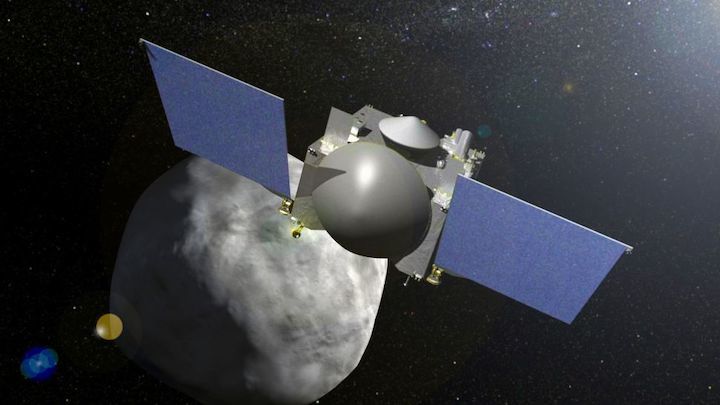Hot on the heels of successfully snagging hunks of space rock in October, the scientists behind NASA's OSIRIS-REx asteroid sample-return mission are contemplating sending the spacecraft to study a second asteroid in 2029, this time the infamous Apophis.
If that appointment comes to be, the spacecraft will arrive at Apophis in April 2029, just over a week after the asteroid makes a hair-raisingly close approach to Earth, within about 19,800 miles (31,900 kilometers) of our planet's surface. Scientists are confident that the asteroid won't impact Earth, but Apophis still has quite a reputation for a space rock, and discovering OSIRIS-REx could visit it provided an unexpected opportunity for the mission.
"Definitely it was a surprise, a very good surprise," Dante Lauretta, a planetary scientist at the University of Arizona and the principal investigator for OSIRIS-REx, told Space.com of the moment in October 2019, when a team member reported that the spacecraft could make a long stay at Apophis.
"I thought for sure extended-mission targets were going to be flyby kind of opportunities, more traditional," Lauretta said. "Those are pretty easy to design in the inner solar system. But when [the OSIRIS-REx mission designer] came back and said we could put the spacecraft into orbit around a second large near-Earth asteroid, I was really excited."
But of course, the priority for the OSIRIS-REx team has been the primary mission of the spacecraft (formally dubbed the Origins, Spectral Interpretation, Resource Identification, Security, Regolith Explorer): collect and deliver a sample from the asteroid Bennu for scientists to analyze in their laboratories on Earth.
That task is going smoothly: OSIRIS-REx collected its space rock on Oct. 20 and will leave Bennu for the long journey home sometime this spring, arriving in September 2023. And just like the Japanese Hayabusa2 asteroid-sampling mission, which returned its samples from an asteroid called Ryugu in December, only a small capsule will actually return to Earth, jettisoned by the main spacecraft, which will then be free to explore other destinations — assuming, of course, the paperwork comes through.
The OSIRIS-REx team plans to propose an extended mission to NASA in the summer of 2022, Lauretta said. Visiting Apophis is one option for what that extended mission could look like, but so far, it's the only target that engineers have found the spacecraft could visit long-term. And a flyby might not do the spacecraft justice in terms of its capabilities and current condition, which Lauretta said is "excellent."
"We don't have a solution that gets us to rendezvous with another asteroid at all right now," Lauretta said. "It really is the unique nature of the Apophis close approach to the Earth in 2029 that even enables us to do this."
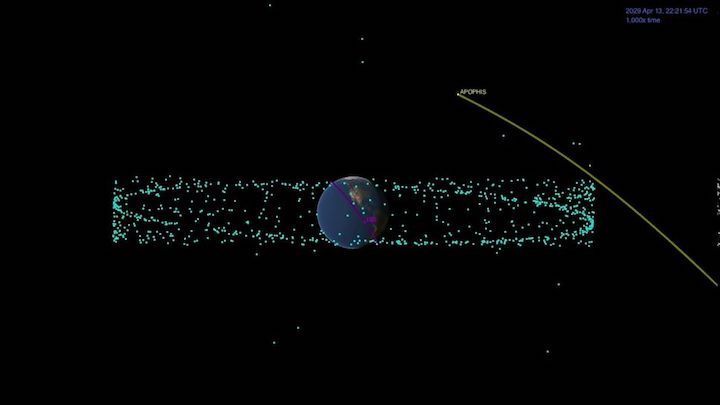
Same spacecraft, new asteroid, new science
OSIRIS-REx has lost only one mode of one instrument; otherwise, everything is in working order, Lauretta said.
In fact, a second asteroid visit would give scientists the opportunity to use an instrument that never actually studied Bennu: OSIRIS-REx was equipped with two lasers for the spacecraft to shoot off the rock and study the echo to facilitate its landing and sampling maneuver. But when the spacecraft arrived, mission personnel learned the asteroid was far too rocky for the system to work and devised an alternative navigation system.
Most lasers don't last long in space, so having two working lasers on a spacecraft older than a decade is rare, Lauretta said. "Having two fresh lasers that we've never used, I'm actually kind of excited about that," he said. "Especially because we built the hardware and we never got to use it. I just feel bad for the instrument. Like, aww, you got all the way to Bennu and all you got to do is get checked out and then we turned you off and you never got to see any action."
In general, an observation campaign at Apophis would likely look quite similar to what the spacecraft did at Bennu.
First, there's a long chain of approach observations, starting with the asteroid seen as just a speck of light, slowly growing into a whole new world. That sequence would begin perhaps around April 8, 2029. OSIRIS-REx won't have a front-row seat to Apophis' close approach, which will occur on April 13.
But seeing the aftermath of the encounter could more than make up for the late arrival, Lauretta said. Scientists expect the brush with Earth's gravity to affect Apophis itself — its precise location, spin and even the space rock's surface and interior structure. The spacecraft would be able to look for signs of what took place during the close approach. "We're really interested in the effect that passing deep into the Earth's gravity field has on the asteroid properties," Lauretta said.
Particularly prominent might be a change in how the asteroid spins. A second possibility the spacecraft could explore is that the close approach would sculpt the space rock's surface as Earth's gravity tugs at Apophis.
"It could trigger mass movement on the surface, and we would definitely be looking for that," Lauretta said. "Even though we might not see the motion due to the gravitational interaction with the Earth, we could see evidence that things had moved recently: freshly exposed surfaces, maybe even a population of particles that were kicked up, that are in orbit around Apophis."
But Lauretta isn't convinced that the drama of the asteroid's flyby is necessary to justify sending OSIRIS-REx on to Apophis once its precious cargo is delivered. Bennu and Apophis belong to different asteroid families with similar structures, and OSIRIS-REx was designed to create incredibly detailed portraits of large space rocks.
"In order to get as much science out of this vehicle as possible, it would be great to go to a different asteroid with a different composition, and collect the same kind of high-fidelity data that we had to generalize our understanding of the physical environment of asteroid surfaces as we've learned from the OSIRIS-REx mission," Lauretta said.
Sending OSIRIS-REx to visit a second asteroid could also help solve perhaps the biggest mystery the spacecraft discovered at Bennu: streams of particles shooting off the rock into space. "Those surprised us so much at Bennu," Lauretta said. "That's a day that I'll never forget, when I saw that first image of what looked like an eruption from the asteroid. And we don't know what's causing those."
The ejections could depend on Bennu's water-rich composition, or they might be a more common trait. As an asteroid of similar size and structure but very different stony material, Apophis could settle that question. "One of the hypotheses is that this is due to micrometeoroids impacting the asteroid," Lauretta said. "If that's the case, Apophis should have just as many particles as Bennu."
And then there's that ineffable quality that Apophis carries with it, from its discovery in 2004, when scientists' measurement of its orbit was uncertain enough that in some scenarios, its 2029 flyby went very, very badly indeed, with the asteroid slamming into Earth. Additional observations cleared up the concern, but it's a difficult reputation to shake for an asteroid named after a mythological Egyptian serpent of chaos.
"It really does enable some unique science," Lauretta said. "Quite honestly, any large asteroid that popped up as a rendezvous target would be super exciting for us. The fact that it was Apophis! Apophis is just famous, so everybody knows exactly what I'm saying when I tell them the asteroid that we want to target."
Quelle: SC
----
Update: 28.01.2021
.
NASA’s OSIRIS-REx Mission Plans for May Asteroid Departure
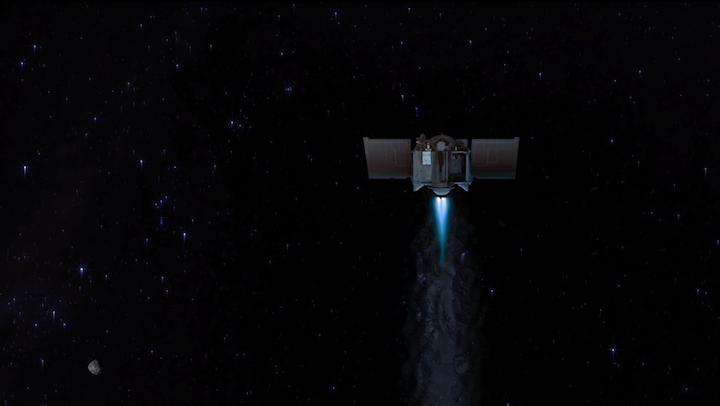
On May 10, NASA’s Origins, Spectral Interpretation, Resource Identification, Security, Regolith Explorer (OSIRIS-REx) spacecraft will say farewell to asteroid Bennu and begin its journey back to Earth. During its Oct. 20, 2020, sample collection event, the spacecraft collected a substantial amount of material from Bennu’s surface, likely exceeding the mission’s requirement of 2 ounces (60 grams). The spacecraft is scheduled to deliver the sample to Earth on Sep. 24, 2023.
“Leaving Bennu’s vicinity in May puts us in the ‘sweet spot,’ when the departure maneuver will consume the least amount of the spacecraft’s onboard fuel,” said Michael Moreau, OSIRIS-REx deputy project manager at NASA’s Goddard Space Flight Center in Greenbelt, Maryland. “Nevertheless, with over 593 miles per hour (265 meters per second) of velocity change, this will be the largest propulsive maneuver conducted by OSIRIS-REx since the approach to Bennu in October 2018.”
The May departure also provides the OSIRIS-REx team with the opportunity to plan a final spacecraft flyby of Bennu. This activity was not part of the original mission schedule, but the team is studying the feasibility of a final observation run of the asteroid to potentially learn how the spacecraft’s contact with Bennu’s surface altered the sample site.
If feasible, the flyby will take place in early April and will observe the sample site, named Nightingale, from a distance of approximately 2 miles (3.2 kilometers). Bennu’s surface was considerably disturbed after the Touch-and-Go (TAG) sample collection event, with the collector head sinking 1.6 feet (48.8 centimeters) into the asteroid’s surface. The spacecraft’s thrusters also disturbed a substantial amount of surface material during the back-away burn.
The mission is planning a single flyby, mimicking one of the observation sequences conducted during the mission’s Detailed Survey phase in 2019. OSIRIS-REx would image Bennu for a full rotation to obtain high-resolution images of the asteroid’s northern and southern hemispheres and equatorial region. The team would then compare these new images with the previous high-resolution imagery of Bennu obtained during 2019.
"OSIRIS-REx has already provided incredible science,” said Lori Glaze, NASA's director of planetary science at the agency's headquarters in Washington. "We're really excited the mission is planning one more observation flyby of asteroid Bennu to provide new information about how the asteroid responded to TAG and to render a proper farewell.”
These post-TAG observations would also give the team a chance to assess the current functionality of science instruments onboard the spacecraft – specifically the OSIRIS-REx Camera Suite (OCAMS), OSIRIS-REx Thermal Emission Spectrometer (OTES), OSIRIS-REx Visible and Infrared Spectrometer (OVIRS), and OSIRIS-REx Laser Altimeter (OLA). It is possible dust coated the instruments during the sample collection event and the mission wants to evaluate the status of each. Understanding the health of the instruments is also part of the team’s assessment of possible extended mission opportunities after the sample is delivered to Earth.
The spacecraft will remain in asteroid Bennu’s vicinity until May 10, when the mission will enter its Earth Return Cruise phase. As it approaches Earth, OSIRIS-REx will jettison the Sample Return Capsule (SRC). The SRC will then travel through the Earth’s atmosphere and land under parachutes at the Utah Test and Training Range.
Once recovered, NASA will transport the capsule to the curation facility at the agency’s Johnson Space Center in Houston and distribute the sample to laboratories worldwide, enabling scientists to study the formation of our solar system and Earth as a habitable planet.
Goddard provides overall mission management, systems engineering, and the safety and mission assurance for OSIRIS-REx. Dante Lauretta of the University of Arizona in Tucson is the principal investigator, and the University of Arizona also leads the science team and the mission’s science observation planning and data processing. Lockheed Martin Space in Littleton, Colorado, built the spacecraft and provides flight operations. Goddard and KinetX Aerospace are responsible for navigating the OSIRIS-REx spacecraft. OSIRIS-REx is the third mission in NASA’s New Frontiers Program, which NASA’s Marshall Space Flight Center in Huntsville, Alabama, manages for the agency’s Science Mission Directorate in Washington.
Quelle: NASA
----
Update: 2.02.2021
.
All Systems Go for OSIRIS-REx Departure from Asteroid Bennu and Historic Sample Return to Earth
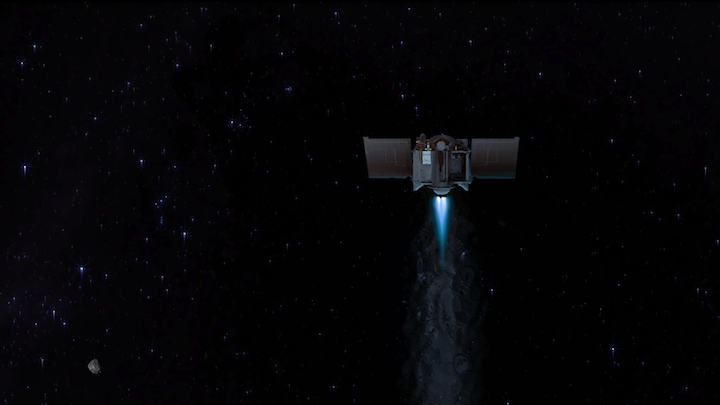
NASA’s Origins, Spectral Interpretation, Resource Identification, Security, Regolith Explorer (OSIRIS-REx) mission has been a huge success. The spacecraft has been studying the asteroid Bennu in great detail, and last October, it collected samples of rock, sand and dust for later return to Earth. Now, mission scientists are preparing OSIRIS-REx to leave Bennu behind on May 10, 2021. This was the first U.S. mission to ever obtain samples from an asteroid for delivery back to Earth.
“Leaving Bennu’s vicinity in May puts us in the ‘sweet spot,’ when the departure maneuver will consume the least amount of the spacecraft’s onboard fuel,” said Michael Moreau, OSIRIS-REx deputy project manager at NASA’s Goddard Space Flight Center in Greenbelt, Maryland. “Nevertheless, with over 593 miles per hour (265 meters per second) of velocity change, this will be the largest propulsive maneuver conducted by OSIRIS-REx since the approach to Bennu in October 2018.”
The departure from Bennu will be the beginning of the long journey back to Earth, which will take a couple years. The spacecraft is expected to arrive back home on Sept. 24, 2023.
On Oct. 20, 2020, OSIRIS-REx collected material from a fairly small, flatter region called Nightingale. The sample collection was successful, and scientists say that the spacecraft was able to obtain more than the hoped-for two ounces (60 grams).
Quelle: AS
----
Update: 3.04.2021
.
OSIRIS-REx to make final close approach to asteroid before heading back to Earth
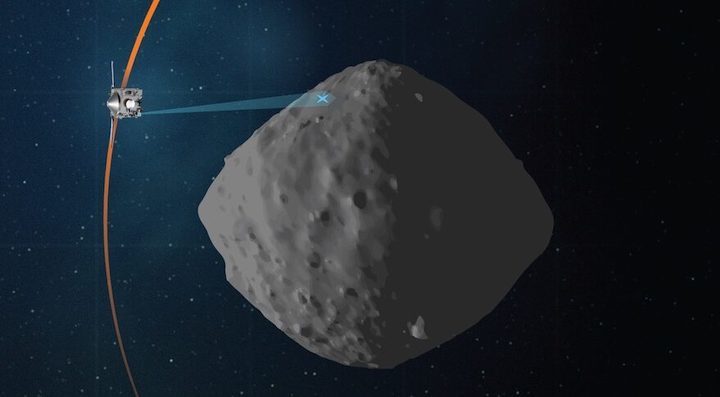
WASHINGTON — NASA’s OSIRIS-REx spacecraft will make one final close approach to the asteroid it collected samples from next week before heading back to Earth.
On April 7, the spacecraft will pass 3.7 kilometers above the location on the asteroid Bennu called Nightingale where, in October, the spacecraft briefly touched down and collected as much as several hundred grams of material, now stored in the spacecraft.
Immediately after that sample collection maneuver, the mission had no plans to return to the vicinity of Bennu. However, NASA decided to make a final pass over the touchdown site to see what changes the sampling made to the Nightingale region, like the creation of a crater.
“We sat down and did a risk assessment, and we decided it was very low risk and the science return was very important. So, we are going back to look at the site and see if we can determine the crater,” Dante Lauretta, principal investigator for OSIRIS-REx at the University of Arizona, said during a March 17 presentation about the mission at the 52nd Lunar and Planetary Sciences Conference online.
He predicted that the site should have not just a single crater but as many as five: one created by the sampling mechanism and four from thrusters on the spacecraft that fired to brake the spacecraft’s descent and pull it away from the surface. “There should be five, or some kind of cloverleaf pattern from all of that interaction with the surface,” he said.
Analysis of data collected during that Oct. 20 sampling mechanism, at the end of a robotic arm extended from the bottom of the spacecraft, went deeper into the surface than predicted. The sampling head went 48.8 centimeters below the surface before the spacecraft stopped its descent and starting moving back up.
“The surface was not slowing us down at all,” he said. “If we hadn’t fired the back-away thrusters, we probably would have sunk in meters into the surface of this asteroid, which is fascinating to think about.”
Shortly after the sample collection maneuver, images showed some material leaking out of the sampling head. That caused the mission to accelerate efforts to stow the sample collection unit in a capsule that will store it during the trip back to Earth.
“We definitely lost tens of grams of sample from the time we collected it until the time we stowed,” Lauretta said. “We’re still confident that there’s substantial amounts of material in that return capsule ready to come home.”
Because of the accelerated effort to stow the sampling head, the mission did not attempt to measure exactly how much material was stowed by spinning the spacecraft and measuring the difference in its moment of inertia from before the sampling maneuver. However, visual estimates of the sampling head suggest it contains at least several hundred grams of material. “We feel like we collected substantially more than our 60-gram requirement,” he said.
The flyby of the Nightingale site will be the last time OSIRIS-REx approaches Bennu. The spacecraft will begin its trip back to Earth May 10, arriving on Sept. 24, 2023. The capsule containing the samples will land in the Utah desert. “We’re very excited to get those samples into our labs and unravel the history of Bennu and the solar system,” he said.
Quelle: SN
----
Update: 10.04.2021
.
NASA’s OSIRIS-REx Completes Final Tour of Asteroid Bennu
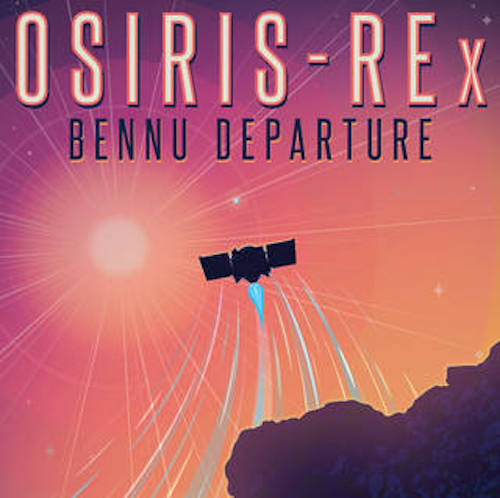
NASA’s OSIRIS-REx completed its last flyover of Bennu around 6 a.m. EDT (4 a.m. MDT) April 7 and is now slowly drifting away from the asteroid; however, the mission team will have to wait a few more days to find out how the spacecraft changed the surface of Bennu when it grabbed a sample of the asteroid.
The OSIRIS-REx team added this flyby to document surface changes resulting from the Touch and Go (TAG) sample collection maneuver Oct. 20, 2020. “By surveying the distribution of the excavated material around the TAG site, we will learn more about the nature of the surface and subsurface materials along with the mechanical properties of the asteroid,” said Dr. Dante Lauretta, principal investigator for OSIRIS-REx at the University of Arizona.
During the flyby, OSIRIS-REx imaged Bennu for 5.9 hours, covering more than a full rotation of the asteroid. It flew within 2.1 miles’ (3.5 kilometers) distance to the surface of Bennu – the closest it’s been since the TAG sample collection event.
It will take until at least April 13 for OSIRIS-REx to downlink all of the data and new pictures of Bennu’s surface recorded during the flyby. It shares the Deep Space Network antennas with other missions like Mars Perseverance, and typically gets 4–6 hours of downlink time per day. “We collected about 4,000 megabytes of data during the flyby,” said Mike Moreau, deputy project manager of OSIRIS-REx at NASA’s Goddard Space Flight Center in Greenbelt, Maryland. “Bennu is approximately 185 million miles from Earth right now, which means we can only achieve a downlink data-rate of 412 kilobits per second, so it will take several days to download all of the flyby data.”
Once the mission team receives the images and other instrument data, they will study how OSIRIS-REx jumbled up Bennu’s surface. During touchdown, the spacecraft’s sampling head sunk 1.6 feet (48.8 centimeters) into the asteroid’s surface and simultaneously fired a pressurized charge of nitrogen gas. The spacecraft’s thrusters kicked up a large amount of surface material during the back-away burn – launching rocks and dust in the process.
OSIRIS-REx, with its pristine and precious asteroid cargo, will remain in the vicinity of Bennu until May 10 when it will fire its thrusters and begin its two-year cruise home. The mission will deliver the asteroid sample to Earth Sept. 24, 2023.
NASA’s Goddard Space Flight Center in Greenbelt, Maryland, provides overall mission management, systems engineering, and the safety and mission assurance for OSIRIS-REx (Origins Spectral Interpretation Resource Identification Security - Regolith Explorer). Dante Lauretta of the University of Arizona, Tucson, is the principal investigator, and the University of Arizona also leads the science team and the mission’s science observation planning and data processing. Lockheed Martin Space in Denver built the spacecraft and provides flight operations. Goddard and KinetX Aerospace are responsible for navigating the OSIRIS-REx spacecraft. OSIRIS-REx is the third mission in NASA’s New Frontiers Program, which is managed by NASA’s Marshall Space Flight Center in Huntsville, Alabama, for the agency’s Science Mission Directorate in Washington.
Quelle: NASA
----
Update: 16.04.2021
.
NASA's OSIRIS-REx Leaves its Mark on Asteroid Bennu
Like boot prints on the Moon, NASA's OSIRIS-REx spacecraft left its mark on asteroid Bennu. Now, new images — taken during the spacecraft's final fly-over on April 7 — reveal the aftermath of its historic encounter with the asteroid.
The spacecraft flew within 2.3 miles (3.7 km) of the asteroid — the closest it has been since the Touch-and-Go, or TAG, sample collection event on Oct. 20, 2020. During TAG, the spacecraft's sampling head sunk 1.6 feet (48.8 centimeters) into the asteroid's surface and simultaneously fired a pressurized charge of nitrogen gas, churning up surface material and driving some into the collection chamber. The spacecraft's thrusters also launched rocks and dust during the maneuver to reverse course and safely back away from the asteroid.
Comparing the two images reveals obvious signs of surface disturbance. At the sample collection point, there appears to be a depression, with several large boulders evident at the bottom, suggesting that they were exposed by sampling. There is a noticeable increase in the amount of highly reflective material near the TAG point against the generally dark background of the surface, and many rocks were moved around.
Where thrusters fired against the surface, substantial mass movement is apparent. Multiple sub-meter boulders were mobilized by the plumes into a campfire ring–like shape — similar to rings of boulders seen around small craters pocking the surface.
Jason Dworkin, the mission's project scientist at NASA’s Goddard Space Flight Center in Greenbelt, Maryland, noticed that one boulder measuring 4 feet (1.25 meters) across on the edge of the sampling site seemed to appear only in the post-TAG image. “The rock probably weighs around a ton, with a mass somewhere between a cow and a car.”
Dante Lauretta, of the University of Arizona and the mission's principal investigator, later pointed out that this boulder is likely one of those present in the pre-TAG image, but much nearer the sampling location, and estimates it was thrown a distance of 40 feet (about 12 meters) by the sample collection event.
In order to compare the before and after images, the team had to meticulously plan this final flyover. "Bennu is rough and rocky, so if you look at it from a different angle or capture it at a time when the sun is not directly overhead, that dramatically changes what the surface looks like," says Dathon Golish, a member of the OSIRIS-REx image processing working group, headquartered at the University of Arizona. "These images were deliberately taken close to noon, with the Sun shining straight down, when there's not as many shadows."
"These observations were not in the original mission plan, so we were excited to go back and document what we did," Golish said. "The team really pulled together for this one last hurrah."
The spacecraft will remain in Bennu's vicinity until departure on May 10, when the mission will begin its two-year return cruise back to Earth. As it approaches Earth, the spacecraft will jettison the Sample Return Capsule (SRC) that contains the sample from Bennu. The SRC will then travel through Earth’s atmosphere and land under parachutes at the Utah Test and Training Range on Sept. 24, 2023.
Once recovered, the capsule will be transported to the curation facility at NASA’s Johnson Space Center in Houston, where the sample will be removed for distribution to laboratories worldwide, enabling scientists to study the formation of our solar system and Earth as a habitable planet. NASA will set 75% of the sample aside for future generations to study with technologies not invented yet.
The OSIRIS-REx mission is the first NASA mission to visit a near-Earth asteroid, survey the surface, and collect a sample to deliver to Earth.
NASA's Goddard Space Flight Center in Greenbelt, Maryland, provides overall mission management, systems engineering, and the safety and mission assurance for OSIRIS-REx. Dante Lauretta of the University of Arizona, Tucson, is the principal investigator, and the University of Arizona also leads the science team and the mission's science observation planning and data processing. Lockheed Martin Space in Denver built the spacecraft and provides flight operations. Goddard and KinetX Aerospace are responsible for navigating the OSIRIS-REx spacecraft. OSIRIS-REx is the third mission in NASA's New Frontiers Program, which is managed by NASA’s Marshall Space Flight Center in Huntsville, Alabama, for the agency’s Science Mission Directorate in Washington, D.C.
Quelle: NASA
----
Update: 8.05.2021
.
NASA Invites Public, Media to Watch Asteroid Mission Begin Return to Earth
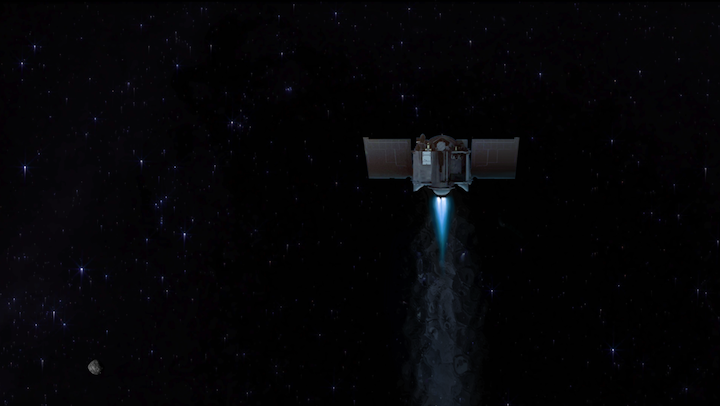
NASA invites the public and the media to watch its first asteroid sample return mission begin a two-year cruise home at 4 p.m. EDT Monday, May 10, on NASA Television, the NASA app, and the agency’s website. The public can follow along on the NASA Solar System Instagram, Twitter, and Facebook accounts using #ToBennuAndBack, and ask questions about the mission by commenting on an Instagram story between 12 p.m. EDT, May 10 and 12 p.m. EDT, May 11. Answers will post to NASA Solar System’s Instagram stories on May 11.
Origins, Spectral Interpretation, Resource Identification, Security, Regolith Explorer (OSIRIS-REx) is the first NASA mission to visit a near-Earth asteroid, survey the surface, and collect a sample to deliver to Earth. During the broadcast, scientists will reveal new imagery from the mission's final flyover of the asteroid Bennu and discuss the tense moments from the sample grab in October 2020. The broadcast also will cover how the team engineered its way out of challenges that threatened its mission.
At approximately 4:16 p.m. EDT, the OSIRIS-REx control room located at Lockheed Martin, in Littleton, Colorado, will receive a confirmation that the spacecraft fired its main thrusters to push away from asteroid Bennu’s orbit, approximately 16 minutes after it happened. After 7 minutes of firing its thrusters, OSIRIS-REx will officially start its long journey home with more than 2.1 ounces (60 grams) of asteroid material.
The OSIRIS-REx departure sequence is the mission's most significant maneuver since it arrived at Bennu in 2018. The spacecraft’s thrusters must change its velocity by 595 miles per hour (958 kilometers per hour) for OSIRIS-REx's path to intersect Earth and achieve a successful sample return at the Utah Test and Training Range on Sept. 24, 2023.
There is no straight path back to Earth. Like a quarterback throwing a long pass to where a receiver will be in the future, OSIRIS-REx is traveling to where the Earth will be. The spacecraft will circle the Sun twice, covering 1.4 billion miles (2.3 billion kilometers) over to catch up with Earth.
OSIRIS-REx made history many times during its two and half years of operations on the asteroid, including breaking its own record for the closest orbit of a planetary body by a spacecraft. Bennu is the smallest celestial object ever orbited by a human-built spacecraft.
OSIRIS-REx will bring back the largest sample collected by a NASA mission since the Apollo astronauts returned with Moon rocks. Scientists plan to analyze the sample to learn about the formation of our solar system and the development of Earth as a habitable planet.
Once recovered, the capsule will be transported to the curation facility at NASA’s Johnson Space Center in Houston, where the sample will be removed for distribution to laboratories worldwide. NASA will set aside 75% of the samples for future generations to study with technologies not yet created.
Quelle: NASA
----
Update: 12.05.2021
.
NASA spacecraft begins 2-year trip home with asteroid rubble
A NASA spacecraft is headed back to Earth with rubble it collected from an asteroid nearly 200 million miles away
CAPE CANAVERAL, Fla. -- With rubble from an asteroid tucked inside, a NASA spacecraft fired its engines and began the long journey back to Earth on Monday, leaving the ancient space rock in its rearview mirror.
The trip home for the robotic prospector, Osiris-Rex, will take two years.
Osiris-Rex reached asteroid Bennu in 2018 and spent two years flying near and around it, before collecting rubble from the surface last fall.
The University of Arizona’s Dante Lauretta, the principal scientist, estimates the spacecraft holds between a half pound and 1 pound (200 grams and 400 grams) of mostly bite-size chunks. Either way, it easily exceeds the target of at least 2 ounces (60 grams).
It will be the biggest cosmic haul for the U.S. since the Apollo moon rocks. While NASA has returned comet dust and solar wind samples, this is the first time it's gone after pieces of an asteroid. Japan has accomplished it twice, but in tiny amounts.
Scientists described Monday's departure from Bennu's neighborhood as bittersweet.
“I’ve been working on getting a sample back from an asteroid since my daughter was in diapers and now she’s graduating from high school, so it's been a long journey,” said NASA project scientist Jason Dworkin.
Added Lauretta: “We have gotten used to being at Bennu and seeing new and exciting images and data coming back to us here on Earth."
Osiris-Rex was already nearly 200 miles (300 kilometers) from the solar-orbiting Bennu when it fired its main engines Monday afternoon for a fast, clean get-away.
Colorado-based flight controllers for spacecraft builder Lockheed Martin applauded when confirmation arrived of the spacecraft's departure: “We're bringing the samples home!”
Scientists hope to uncover some of the solar system’s secrets from the samples vacuumed last October from Bennu’s dark, rough, carbon-rich surface. The asteroid is an estimated 1,600 feet (490 meters) wide and 4.5 billion years old.
Bennu — considered a broken chunk from a bigger asteroid — is believed to hold the preserved building blocks of the solar system. The returning pieces could shed light on how the planets formed and how life arose on Earth. They also could improve Earth’s odds against any incoming rocks.
Although the asteroid is 178 million miles (287 million kilometers) away, Osiris-Rex will put another 1.4 billion miles (2.3 billion kilometers) on its odometer to catch up with Earth.
The SUV-size spacecraft will circle the sun twice before delivering its small sample capsule to Utah's desert floor on Sept. 24, 2023, to end the more than $800 million mission. It launched from Cape Canaveral in 2016.
The precious samples will be housed at a new lab under construction at NASA's Johnson Space Center in Houston, already home to hundreds of pounds of lunar material collected by the 12 Apollo moonwalkers from 1969 to 1972.
Scientists initially thought the spacecraft stored 2 pounds (1 kilogram) of asteroid rubble, but more recently revised their estimate downward. They won't know for certain how much is on board until the capsule is opened after touchdown.
“Every bit of sample is valuable,” Dworkin said. “We have to be patient.”
NASA has lots more asteroid projects planned.
Set to launch in October, a spacecraft named Lucy will fly past swarms of asteroids out near Jupiter, while a spacecraft known as Dart will blast off in November in an attempt to redirect an asteroid as part of a planetary protection test. Then in 2022, the Psyche spacecraft will take off for an odd, metallic asteroid bearing the same name. None of these missions, however, involve sample return.
Quelle: abcNews
+++
NASA’s OSIRIS-REx Spacecraft Heads for Earth with Asteroid Sample

After nearly five years in space, NASA’s Origins, Spectral Interpretation, Resource Identification, Security, Regolith Explorer (OSIRIS-REx) spacecraft is on its way back to Earth with an abundance of rocks and dust from the near-Earth asteroid Bennu.
On Monday, May 10, at 4:23 p.m. EDT the spacecraft fired its main engines full throttle for seven minutes – its most significant maneuver since it arrived at Bennu in 2018. This burn thrust the spacecraft away from the asteroid at 600 miles per hour (nearly 1,000 kilometers per hour), setting it on a 2.5-year cruise towards Earth.
After releasing the sample capsule, OSIRIS-REx will have completed its primary mission. It will fire its engines to fly by Earth safely, putting it on a trajectory to circle the sun inside of Venus’ orbit.
After orbiting the Sun twice, the OSIRIS-REx spacecraft is due to reach Earth Sept. 24, 2023. Upon return, the capsule containing pieces of Bennu will separate from the rest of the spacecraft and enter Earth’s atmosphere. The capsule will parachute to the Utah Test and Training Range in Utah's West Desert, where scientists will be waiting to retrieve it.
“OSIRIS-REx’s many accomplishments demonstrated the daring and innovate way in which exploration unfolds in real time,” said Thomas Zurbuchen, associate administrator for science at NASA Headquarters. “The team rose to the challenge, and now we have a primordial piece of our solar system headed back to Earth where many generations of researchers can unlock its secrets.”
To realize the mission’s multi-year plan, a dozen navigation engineers made calculations and wrote computer code to instruct the spacecraft when and how to push itself away from Bennu. After departing from Bennu, getting the sample to Earth safely is the team’s next critical goal. This includes planning future maneuvers to keep the spacecraft on course throughout its journey.
“Our whole mindset has been, ‘Where are we in space relative to Bennu?’” said Mike Moreau, OSIRIS-REx deputy project manager at NASA’s Goddard Space Flight Center in Greenbelt, Maryland. “Now our mindset has shifted to ‘Where is the spacecraft in relation to Earth?’”
The navigation cameras that helped orient the spacecraft in relation to Bennu were turned off April 9, after snapping their last images of the asteroid. With Bennu in the rearview mirror, engineers are using NASA’s Deep Space Network of global spacecraft communications facilities to steer the OSIRIS-REx by sending it radio signals. By measuring the frequency of the waves returned from the spacecraft transponder, engineers can tell how fast OSIRIS-REx is moving. Engineers measure how long it takes for radio signals to get from the spacecraft back to Earth in order to determine its location.
Exceeding Mission Expectations
The May 10 departure date was precisely timed based on the alignment of Bennu with Earth. The goal of the return maneuver is to get the spacecraft within about 6,000 miles (approximately 10,000 kilometers) of Earth in September 2023. Although OSIRIS-REx still has plenty of fuel remaining, the team is trying to preserve as much as possible for a potential extended mission to another asteroid after returning the sample capsule to Earth. The team will investigate the feasibility of such a mission this summer.
The spacecraft’s course will be determined mainly by the Sun’s gravity, but engineers will need to occasionally make small course adjustments via engine burns.
“We need to do regular corrections to bring the trajectory increasingly closer to Earth’s atmosphere for the sample release, and to account for small errors that might have accumulated since the last burn,” said Peter Antreasian, OSIRIS-REx navigation lead at KinetX Aerospace, which is based in Simi Valley, California.
The team will perform course adjustments a few weeks prior to Earth re-entry in order to precisely target the location and angle for the sample capsule’s release into Earth’s atmosphere. Coming in too low could cause the capsule to bounce out of the atmosphere like a pebble skipping off a lake; too high and the capsule could burn up due to friction and heat from the atmosphere. If OSIRIS-REx fails to release the capsule, the team has a backup plan to divert it away from Earth and try again in 2025.
“There’s a lot of emotion within the team about departure,” Moreau said. “I think everyone has a great sense of accomplishment, because we faced all these daunting tasks and were able to accomplish all the objectives thrown at us. But there’s also some nostalgia and disappointment that this part of the mission is coming to an end.”
OSIRIS-REx exceeded many expectations. Most recently, in the midst of a global pandemic, the team flawlessly executed the most mission’s critical operation, collecting more than 2 ounces (60 grams) of soil from Bennu’s surface.
Leading up to sample collection, a number of surprises kept the team on its toes. For example, a week after the spacecraft entered its first orbit around Bennu, on Dec. 31, 2018, the team realized that the asteroid was releasing small pieces of rock into space.
“We had to scramble to verify that the small particles being ejected from the surface did not present a hazard to the spacecraft,” Moreau said.
Upon arrival at the asteroid, team members also were astonished to find that Bennu is littered with boulders.
“We really had this idea that we were arriving on an asteroid with open real estate,” said Heather Enos, OSIRIS-REx deputy principal investigator, based at the University of Arizona, Tucson. “The reality was a big shocker.”
To overcome the extreme and unexpected ruggedness of Bennu’s surface, engineers had to quickly develop a more accurate navigation technique to target smaller-than-expected sites for sample collection.
The OSIRIS-REx mission was instrumental in both confirming and refuting several scientific findings. Among those confirmed was a technique that used observations from Earth to predict that the minerals on the asteroid would be carbon-rich and show signs of ancient water. One finding that proved unsuccessful was that Bennu would have a smooth surface, which scientists predicted by measuring how much heat radiated off its surface.
Scientists will use the information gleaned from Bennu to refine theoretical models and improve future predictions.
“This mission emphasizes why we have to do science and exploration in multiple ways – both from Earth and from up-close in space – because assumptions and models are just that,” Enos said.
Goddard provides overall mission management, systems engineering, and the safety and mission assurance for OSIRIS-REx. Dante Lauretta of the University of Arizona, Tucson, is the principal investigator. The university leads the science team and the mission's science observation planning and data processing. Lockheed Martin Space in Littleton, Colorado, built the spacecraft and provides flight operations. Goddard and KinetX Aerospace are responsible for navigating the OSIRIS-REx spacecraft. OSIRIS-REx is the third mission in NASA's New Frontiers Program, managed by NASA's Marshall Space Flight Center in Huntsville, Alabama, for the agency's Science Mission Directorate Washington.
Quelle: NASA

